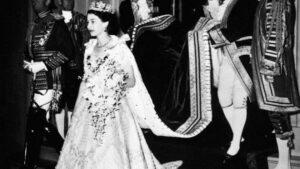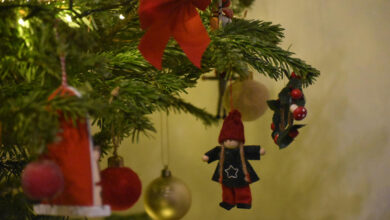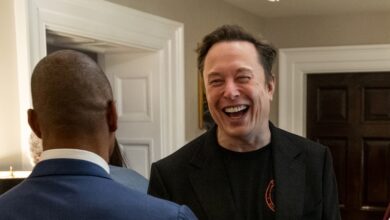Before wearing the Imperial State Crown, Queen Elizabeth II knelt at the Westminster Abbey altar for a moment of silent, private prayer.
The three-hour coronation in 1953 contained myriad oaths and symbols, but the most ancient rite — Archbishop of Canterbury Geoffrey Fisher anointing Elizabeth with holy oil — sought the highest possible blessing on her life’s work and eventual death.
“Our Lord Jesus Christ, the Son of God,” he prayed, “who by his Father was anointed with the oil of gladness … that by the assistance of His heavenly grace you may govern and preserve the people committed to your charge in wealth, peace and godliness; and after a long and glorious course of ruling a temporal kingdom wisely, justly and religiously, you may at last be made partaker of an eternal kingdom.”
 Televised for the first time, 27 million BBC viewers watched what Oxford Don C.S. Lewis called the “tragic splendour” of this drama.
Televised for the first time, 27 million BBC viewers watched what Oxford Don C.S. Lewis called the “tragic splendour” of this drama.
“Over here people did not get that fairy-tale feeling about the coronation,” he noted, writing to an American friend. “What impressed most who saw it was the fact that the Queen herself appeared to be quite overwhelmed by the sacramental side of it”
It was “a feeling of (one hardly knows how to describe it) — awe — pity — pathos — mystery. The pressing of that huge, heavy crown on that small, young head becomes a sort of symbol of the situation of humanity itself: humanity called by God to be his vice-regent and high priest on earth, yet feeling so inadequate.”
Few could have imagined that the woman some now call “Elizabeth the Great” would reign for 70 years, striving to lead by example after the suffering of World War II, into an age in which humanity would be united by the internet, terrorism, pandemics and other challenges.
Throughout her life, Queen Elizabeth II understood the symbolic importance of kneeling, according to former Durham Bishop N.T. Wright. After one Church of England synod, she privately expressed surprise — disappointment, even — that worshippers in Westminster Abbey simply lined up to receive Holy Communion, instead of kneeling.
“Kneeling was important to her,” said the popular author, in a “Premier Christianity” tribute. In his encounters with her, Wright found the queen “very friendly and clearly a very devout, what we would consider ‘old fashioned’ Church of England Christian. I remember thinking during more than one Christmas broadcast, she has just preached the Gospel to the nation in a way that perhaps nobody else could have done.”
While the queen delivered thousands of public addresses, her Christmas talks — surrounded by family pictures and holiday decorations — were the occasions when she most openly discussed her faith and the challenges facing the nation and even her own family.
In her first Christmas message, she welcomed the chance to face her people through television. “New inventions” are rarely the problem, she noted. “The trouble is caused by unthinking people who carelessly throw away ageless ideals as if they were old and outworn machinery. They would have religion thrown aside, morality in personal and public life made meaningless, honesty counted as foolishness and self-interest set up in place of self-restraint.”
In 2011, she warned: “Although we are capable of great acts of kindness, history teaches us that we sometimes need saving from ourselves — from our recklessness or our greed. God sent into the world a unique person — neither a philosopher nor a general (important though they are) — but a Savior, with the power to forgive.”
In what would be her last Christmas message, the frail queen reflected on losing her husband, Prince Philip, while reminding viewers life is about “final partings,” as well as new births.
“For me and my family, even with one familiar laugh missing this year, there will be joy in Christmas, as we have the chance to reminisce, and see anew the wonder of the festive season through the eyes of our young children,” said Elizabeth. “They teach us all a lesson — just as the Christmas story does — that in the birth of a child, there is a new dawn with endless potential.” And so it was with “the life of Jesus, a man whose teachings have been handed down from generation to generation and have been the bedrock of my faith.”
Terry Mattingly leads GetReligion.org and lives in Oak Ridge, Tennessee.
5 facts about the Queen’s faith
 When news broke Thursday of Queen Elizabeth II’s death at age 96, I immediately consulted with the leading expert of her 70 years on the throne I know: my wife, Tamie.
When news broke Thursday of Queen Elizabeth II’s death at age 96, I immediately consulted with the leading expert of her 70 years on the throne I know: my wife, Tamie.
Seriously, I texted my bride of 32 years.
“Yes, I’ve been watching,” she replied. “The news and social, that is.”
A few years ago, Tamie, a fellow writer, sent the queen a letter and received one back in an enveloped stamped “Royal Mail” from Buckingham Palace.
“She never sat for an interview, so a few documentaries are the closest thing to hearing her asked/answering questions,” Tamie told me. “I thought it was worth writing to tell her how much I enjoyed it, and this response came a few weeks later on her behalf.”
“The Queen wishes me to write and thank you for your card and very kind message,” the reply said.
Did Elizabeth actually see my wife’s letter? Tamie has no way of knowing. I’m a skeptical journalist, so I’m guessing not.
But it’s cool to imagine that she did!
In the meantime, here are five facts about religion in the life of Elizabeth, who wrote the foreword to a 2016 British Bible Society book titled “The Servant Queen and the King She Serves” (that king being Jesus):
1. She was the official head of the Church of England.
The Associated Press obituary by Danica Kirka, Jill Lawless and Sylvia Hui explains:
In Britain’s constitutional monarchy, the queen is head of state but has little direct power; in her official actions she does what the government orders. However, she was not without influence. The queen, officially the head of the Church of England, once reportedly commented that there was nothing she could do legally to block the appointment of a bishop, “but I can always say that I should like more information. That is an indication that the prime minister will not miss.”
2. She spoke openly about her Christian faith.
Writing for Religion News Service, Catherine Pepinster notes:
While Defender of the Faith has been an inherited title and little more, Elizabeth II embraced it and in recent years made it her own, speaking very openly about her faith and explaining how it provided the framework of her life.
She did this mostly through her annual Christmas message, a tradition begun by her grandfather, George V, in 1932, and continued by her father. Her early Christmas Day broadcasts were platitudinous — the holidays as an occasion for family was a frequent theme. In 2000, however, she spoke of the millennium as the 2,000-year anniversary of the birth of Jesus Christ, “who was destined to change the course of our history.”
She went on to speak very personally and frankly about her faith: “For me the teachings of Christ and my own personal accountability before God provide a framework in which I try to lead my life. I, like so many of you, have drawn great comfort in difficult times from Christ’s words and example.” Similar sentiments have been aired at Christmas ever since.
3. Trust in God was ‘foundational’ in her life.
The Washington Times’ Mark A. Kellner reports:
Archbishop of Canterbury Justin Welby, the symbolic head of the global Anglican Communion, lauded the late monarch’s commitment to her Christian faith.
“As a faithful Christian disciple, and also Supreme Governor of the Church of England, she lived out her faith every day of her life,” Archbishop Welby said in a statement. “Her trust in God and profound love for God was foundational in how she led her life — hour by hour, day by day,” he added.
4. She met with five popes in her lifetime.
Francis X. Rocca, the Wall Street Journal’s Vatican correspondent, recounts:
Pope Francis met the queen and the Duke of Edinburgh at the Vatican in 2014, when the royal couple presented him with a gift of whiskey produced at her castle of Balmoral in Scotland.
Queen Elizabeth met with five popes in her lifetime, beginning with Pope Pius XII in 1951, when she was still a princess.
The others she met were Pope Benedict XVI in 2010, Pope John Paul II in 1980, 1982 and 2000 and Pope John XXIII in 1961, according to Catholic News Agency’s Courtney Mares.
5. She was friends with late evangelist Billy Graham.
At Christianity Today, Dudley Delffs points out:
Her friend and confidant Billy Graham attested to the Queen’s love for the Bible, as well as the strength and depth of her Christian faith, in his autobiography, Just As I Am.
“No one in Britain has been more cordial toward us than Her Majesty Queen Elizabeth II,” Graham wrote. “Almost every occasion I have been with her has been in a warm, informal setting, such as a luncheon or dinner, either alone or with a few family members or other close friends.”
They rarely publicized their meetings or leveraged their relationship professionally, but the two enjoyed a friendship that endured for more than 60 years until Graham’s passing in 2018. He wrote, “I always found her very interested in the Bible and its message.”
The Washington Post’s Sarah Pulliam Bailey did a fascinating piece in 2018 fact-checking the portrayal of the relationship between Elizabeth and Graham in the Netflix show “The Crown”.
A bonus fact: The British national anthem “God Save The King” — or, in during the reign of Elizabeth, “God Save The Queen” — dates back at least to the 18th century and possibly the 17th century.
For a bit of final analysis, let’s go back to my original expert.
“She went to church every Sunday,” Tamie said. “It’s kind of ingrained in the culture when you think of her and the monarchy. But I don’t think there will be another British monarch who goes about it like she has.
“I mean, her son, King Charles III, already has said that he’s going to be the ‘Defender of Faiths’ vs. the ‘Defender of the Faith’ so it’s inclusive of all religions,” my wife added. “But I think Elizabeth probably saw this vision of the Church of England kind of being a host to all the other religions. Every year they had a Commonwealth Day service, and she was the one who asked if that could be held at Westminster Abbey and include all of the different faiths.”
For more on that, see “A devout believer, the Queen took her faith seriously” by The Independent’s Laura Elston.







